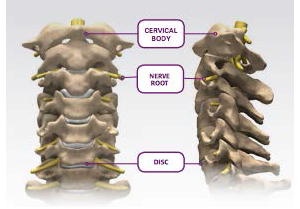Posterior Cervical Fusion (PCF)
The Posterior Cervical Fusion (PCF) is the technique of joining the bones in the back of the cervical spine together. Over time these small bones fuse together to form an internal brace and stabilize the cervical spine, reducing painful motion or spinal cord compression.
In the cervical spine (neck), surgery is often performed via the posterior approach to address a multitude of indications, including degenerative disc disease (DDD), dislocation, fractures, instability, or soft disc herniation.
Download the Posterior Cervical Fusion Patient Brochure to learn more about this procedure and what to expect before, during and after surgery.
Is a PCF Right for Me?
Your physician may determine that the PCF procedure is a good option for you if you require a fusion, are skeletally mature, and have gone through six weeks of non-surgical treatment.
Conversely, your physician may determine that a PCF procedure is not a good option for you if you are not a good candidate for fusion surgery in general due to other medical conditions. These conditions may be associated with a poor tolerance with regard to general anesthesia, inability to tolerate a prone position, and inadequate bone quality preventing adequate fixation of the instrumentation, as well as other indications. It is important to discuss this with your physician in order to determine the best course of treatment for you.
Potential Benefits of a PCF Surgical Procedure
The potential benefit of a PCF surgical procedure to the patient is stabilization, possible reduction in pain, reduction in continuing degeneration, and maintaining stability after a laminectomy (surgery to remove the lamina or back part of the vertebra that covers your spinal canal to relieve pressure on the spinal cord or nerves).
Are There Risks Involved?
Keep in mind that all surgery presents risks and complications that are important to discuss with your physician prior to your surgery. Listening to your physician’s guidance both before and after surgery will help to ensure the best possible outcome from your procedure.
Some potential risks associated with PCF include: axial neck pain, morbidity (incidence of disease), stiffness, loss of range of motion, paralysis, bleeding requiring a blood transfusion, failure of the fusion, failure of the instrumentation, nerve root injury and dural tears.
I have more questions, who can I ask?
In addition to consulting with your physician and medical teams, it often helps to speak to someone who has been through the procedure. To connect with a Patient Ambassador who has already had a PCF surgical procedure, please complete our request form.
NOTE:While this website provides information about many different non-surgical and surgical options, it is not meant to replace any personal conversations that you should have with your physician or other member of your healthcare team. Not all the information here will apply to your individual treatment or its outcome. The information is intended to answer some of your questions and serve as a guideline for you to ask your healthcare team appropriate questions about the procedure.

